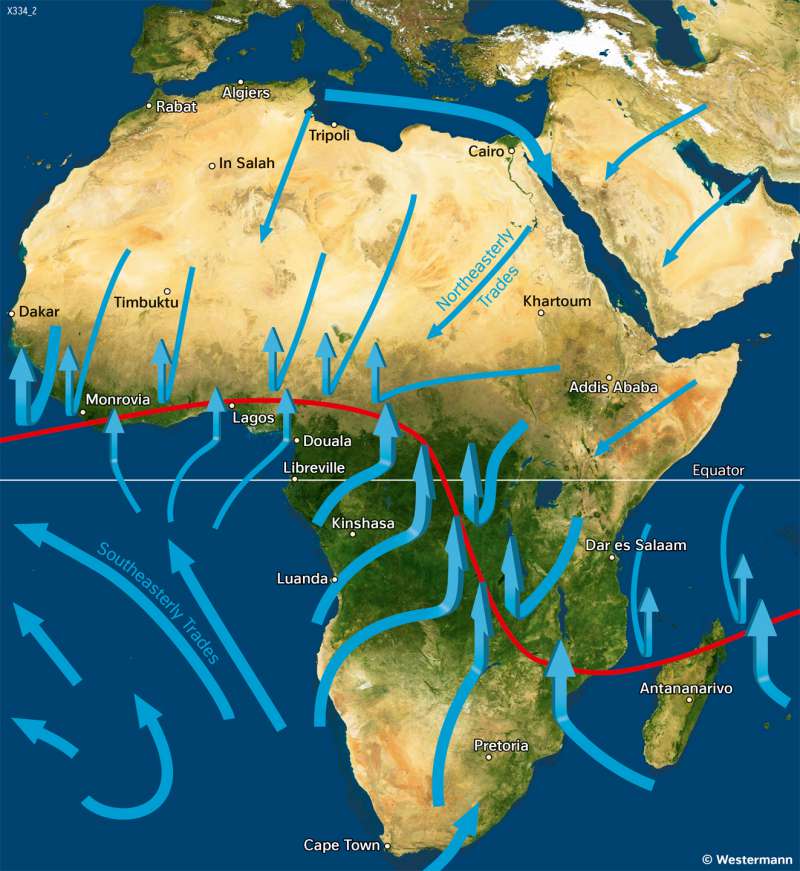Africa - Vegetation in January
Climate and Nile catchment
978-3-14-100890-6 | Page 146 | Ill. 3

Overview
Easily visible on the satellite image is a dark green strip of dense vegetation near the equator, while the light tint in areas further poleward indicates thin or absent vegetation. In the north of the continent, larger islands of vegetation exist only in the Atlas Mountains and the Nile Delta. In the south, on the other hand, there is heavier green cover all year round, both on the Indian Ocean coast and at the tip of the Cape.
Intertropical Convergence Zone (ITCZ)
The changing position of the ITCZ in the course of the year is responsible for the alternation of rainy and dry seasons in large parts of Africa. In January, the ITCZ runs along the coast of West Africa, then bends southwards in the centre of the continent before continuing eastwards again near Zambia. At the ITCZ, the trade winds from the south (humid) and north (humid only in the eastern area, otherwise dry) meet, the air masses rise, cool down, condense, and precipitate extensively. Thus, the area around the ITCZ is rich in precipitation, which also affects the vegetation. In the area of the savannahs south of the equator, the satellite image shows more green in January, which means that the rainy season leads to a spreading and unfolding of the vegetation here.
Vegetation zones
Another characteristic feature is the evenly distributed development of shoots, flowers and leaf fall throughout the year. In the north and south, the rainforest is enclosed by a band of semi-evergreen, partly deciduous rainforests about 100 kilometres wide, which are also called seasonal evergreen rainforests. They are followed by savannah formations, which have developed according to the number of arid months (3-7) and the amount of average annual precipitation (400-1600 mm): from wet savannah to dry savannah to thorn savannah. The wet savannah is made up of forests with a height of 18-20 metres, alternating with grasslands and sparse woodlands. Further polewards, there is, with less than 6-7 humid months and average annual precipitation of less than 1000 millimetres, the dry savannah. With only 2-4.5 humid months, the thorn savannah follows (250-500 mm). It is characterised by a sparse grass cover and thorny shrubs. Most of today's woody and grassy formations are the result of human intervention and vegetation degradation (= deterioration of the vegetation). In the semi-desert formations that follow further polewards, grasses and small thorny shrubs appear, and rain vegetation germinates during episodic precipitation. Sporadic grasses and lichens can also be found in the adjoining deserts. In the Mediterranean north and south fringes, typical Sclerophyllous plants or maquis shrublands are widespread.
Vegetation zones
Another characteristic feature is the evenly distributed development of shoots, flowers and leaf fall throughout the year. In the north and south, the rainforest is enclosed by a band of semi-evergreen, partly deciduous rainforests about 100 kilometres wide, which are also called seasonal evergreen rainforests. They are followed by savannah formations, which have developed according to the number of arid months (3-7) and the amount of average annual precipitation (400-1600 mm): from wet savannah to dry savannah to thorn savannah. The wet savannah is made up of forests with a height of 18-20 metres, alternating with grasslands and sparse woodlands. Further polewards, there is, with less than 6-7 humid months and average annual precipitation of less than 1000 millimetres, the dry savannah. With only 2-4.5 humid months, the thorn savannah follows (250-500 mm). It is characterised by a sparse grass cover and thorny shrubs. Most of today's woody and grassy formations are the result of human intervention and vegetation degradation (= deterioration of the vegetation). In the semi-desert formations that follow further polewards, grasses and small thorny shrubs appear, and rain vegetation germinates during episodic precipitation. Sporadic grasses and lichens can also be found in the adjoining deserts. In the Mediterranean north and south fringes, typical Sclerophyllous plants or maquis shrublands are widespread.




